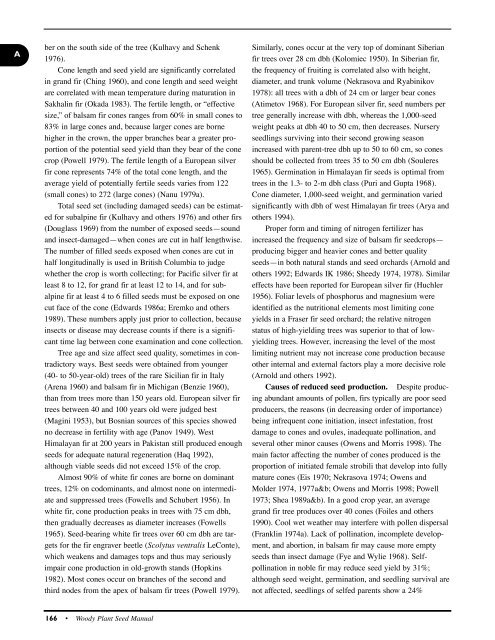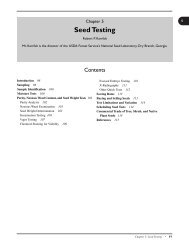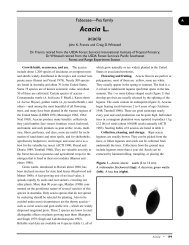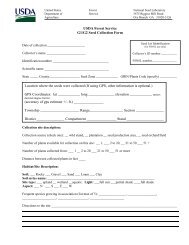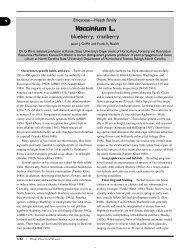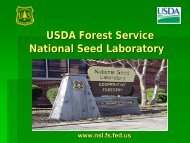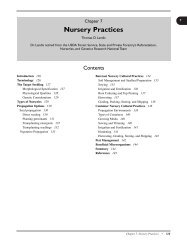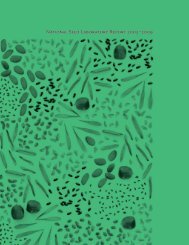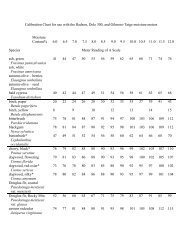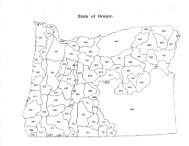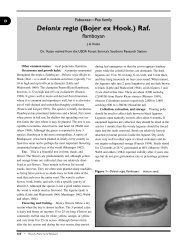Abies - National Seed Laboratory - USDA Forest Service
Abies - National Seed Laboratory - USDA Forest Service
Abies - National Seed Laboratory - USDA Forest Service
Create successful ePaper yourself
Turn your PDF publications into a flip-book with our unique Google optimized e-Paper software.
Aber on the south side of the tree (Kulhavy and Schenk1976).Cone length and seed yield are significantly correlatedin grand fir (Ching 1960), and cone length and seed weightare correlated with mean temperature during maturation inSakhalin fir (Okada 1983). The fertile length, or “effectivesize,” of balsam fir cones ranges from 60% in small cones to83% in large cones and, because larger cones are bornehigher in the crown, the upper branches bear a greater proportionof the potential seed yield than they bear of the conecrop (Powell 1979). The fertile length of a European silverfir cone represents 74% of the total cone length, and theaverage yield of potentially fertile seeds varies from 122(small cones) to 272 (large cones) (Nanu 1979a).Total seed set (including damaged seeds) can be estimatedfor subalpine fir (Kulhavy and others 1976) and other firs(Douglass 1969) from the number of exposed seeds—soundand insect-damaged—when cones are cut in half lengthwise.The number of filled seeds exposed when cones are cut inhalf longitudinally is used in British Columbia to judgewhether the crop is worth collecting; for Pacific silver fir atleast 8 to 12, for grand fir at least 12 to 14, and for subalpinefir at least 4 to 6 filled seeds must be exposed on onecut face of the cone (Edwards 1986a; Eremko and others1989). These numbers apply just prior to collection, becauseinsects or disease may decrease counts if there is a significanttime lag between cone examination and cone collection.Tree age and size affect seed quality, sometimes in contradictoryways. Best seeds were obtained from younger(40- to 50-year-old) trees of the rare Sicilian fir in Italy(Arena 1960) and balsam fir in Michigan (Benzie 1960),than from trees more than 150 years old. European silver firtrees between 40 and 100 years old were judged best(Magini 1953), but Bosnian sources of this species showedno decrease in fertility with age (Panov 1949). WestHimalayan fir at 200 years in Pakistan still produced enoughseeds for adequate natural regeneration (Haq 1992),although viable seeds did not exceed 15% of the crop.Almost 90% of white fir cones are borne on dominanttrees, 12% on codominants, and almost none on intermediateand suppressed trees (Fowells and Schubert 1956). Inwhite fir, cone production peaks in trees with 75 cm dbh,then gradually decreases as diameter increases (Fowells1965). <strong>Seed</strong>-bearing white fir trees over 60 cm dbh are targetsfor the fir engraver beetle (Scolytus ventralis LeConte),which weakens and damages tops and thus may seriouslyimpair cone production in old-growth stands (Hopkins1982). Most cones occur on branches of the second andthird nodes from the apex of balsam fir trees (Powell 1979).Similarly, cones occur at the very top of dominant Siberianfir trees over 28 cm dbh (Kolomiec 1950). In Siberian fir,the frequency of fruiting is correlated also with height,diameter, and trunk volume (Nekrasova and Ryabinikov1978): all trees with a dbh of 24 cm or larger bear cones(Atimetov 1968). For European silver fir, seed numbers pertree generally increase with dbh, whereas the 1,000-seedweight peaks at dbh 40 to 50 cm, then decreases. Nurseryseedlings surviving into their second growing seasonincreased with parent-tree dbh up to 50 to 60 cm, so conesshould be collected from trees 35 to 50 cm dbh (Souleres1965). Germination in Himalayan fir seeds is optimal fromtrees in the 1.3- to 2-m dbh class (Puri and Gupta 1968).Cone diameter, 1,000-seed weight, and germination variedsignificantly with dbh of west Himalayan fir trees (Arya andothers 1994).Proper form and timing of nitrogen fertilizer hasincreased the frequency and size of balsam fir seedcrops—producing bigger and heavier cones and better qualityseeds—in both natural stands and seed orchards (Arnold andothers 1992; Edwards IK 1986; Sheedy 1974, 1978). Similareffects have been reported for European silver fir (Huchler1956). Foliar levels of phosphorus and magnesium wereidentified as the nutritional elements most limiting coneyields in a Fraser fir seed orchard; the relative nitrogenstatus of high-yielding trees was superior to that of lowyieldingtrees. However, increasing the level of the mostlimiting nutrient may not increase cone production becauseother internal and external factors play a more decisive role(Arnold and others 1992).Causes of reduced seed production. Despite producingabundant amounts of pollen, firs typically are poor seedproducers, the reasons (in decreasing order of importance)being infrequent cone initiation, insect infestation, frostdamage to cones and ovules, inadequate pollination, andseveral other minor causes (Owens and Morris 1998). Themain factor affecting the number of cones produced is theproportion of initiated female strobili that develop into fullymature cones (Eis 1970; Nekrasova 1974; Owens andMolder 1974, 1977a&b; Owens and Morris 1998; Powell1973; Shea 1989a&b). In a good crop year, an averagegrand fir tree produces over 40 cones (Foiles and others1990). Cool wet weather may interfere with pollen dispersal(Franklin 1974a). Lack of pollination, incomplete development,and abortion, in balsam fir may cause more emptyseeds than insect damage (Fye and Wylie 1968). Selfpollinationin noble fir may reduce seed yield by 31%;although seed weight, germination, and seedling survival arenot affected, seedlings of selfed parents show a 24%166 • Woody Plant <strong>Seed</strong> Manual


